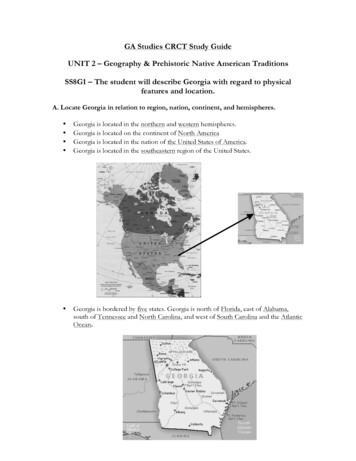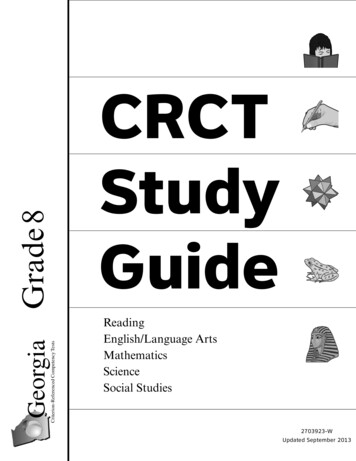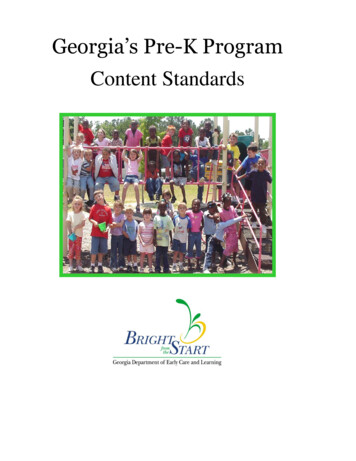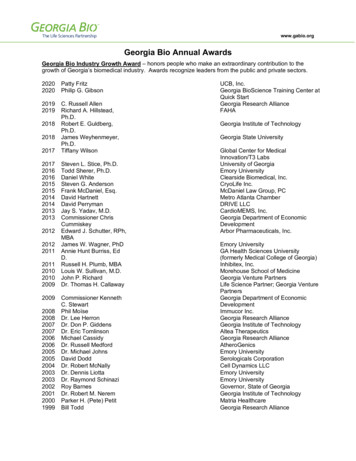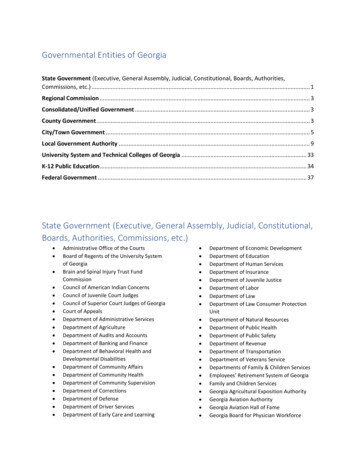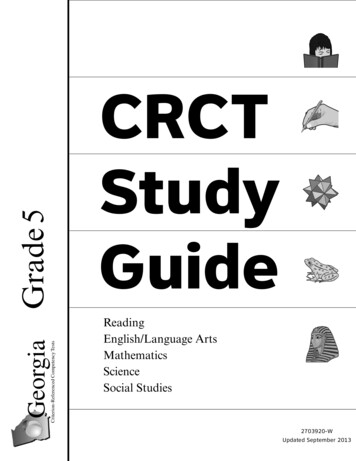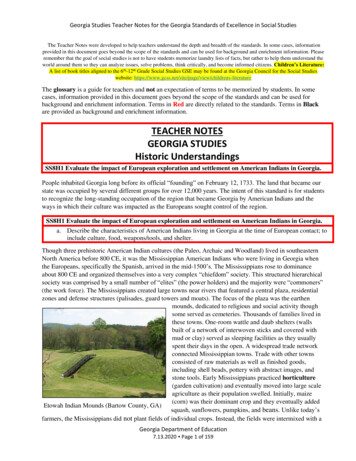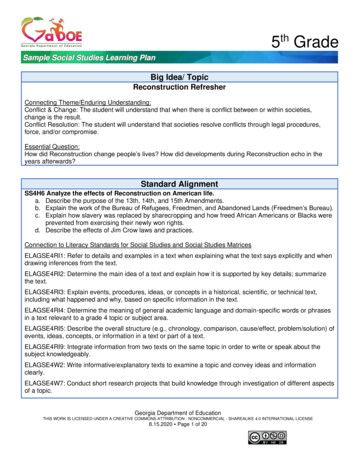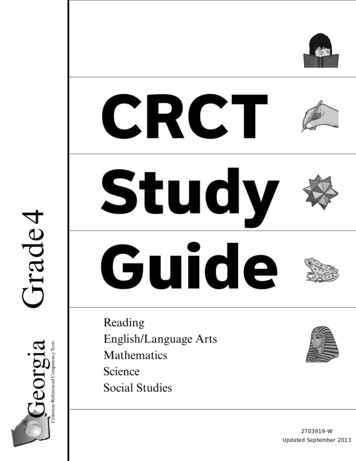
Transcription
Criterion-Referenced Competency TestsGeorgiaGrade 4CRCTStudyGuideReadingEnglish/Language ArtsMathematicsScienceSocial Studies2703919-WUpdated September 2013
Copyright 2013 by Georgia Department of Education.All rights reserved.
Table of ContentsUsing the CRCT Study Guide1About the CRCTOverview of the CRCTWhat is the CRCT?What does the CRCT measure?How are CRCT questions scored?2Preparing for the CRCTTest-Taking StrategiesRelated Links4Chapter 1ReadingReading Skills and Vocabulary AcquisitionLiterary ComprehensionInformation and Media LiteracyPractice QuizSolutions10Chapter 2English/Language ArtsGrammar/Sentence ConstructionResearch/Writing ProcessPractice QuizSolutions26Chapter 3MathematicsNumber and OperationsMeasurement and Data AnalysisGeometryAlgebraPractice QuizSolutions42Copyright 2013 by Georgia Department of Education.All rights reserved.
Chapter 4ScienceEarth SciencePhysical ScienceLife SciencePractice QuizSolutions66Chapter 5Social ractice QuizSolutions82Copyright 2013 by Georgia Department of Education.All rights reserved.
Using the CRCT Study GuideThis Study Guide focuses on the knowledge and skills that are tested on theGeorgia Criterion-Referenced Competency Tests (CRCT). It is designed forteachers to use with their students and for parents to use with their children.Go to www.gadoe.org/ to find further information about and support forthe CRCT.The following section of this guide, “About the CRCT,” contains an overview ofthe CRCT and test-taking strategies to review with your students.–The content tested on the CRCT is based on Georgia’s state-mandatedcontent standards, which describe what all students should know,understand, and be able to do.The chapters of this guide are organized by subject. In each chapter you canexplore the skills needed to succeed in a specific tested domain (grouping ofsimilar content standards). The subject chapters include a snapshot of eachdomain, instructional Activities that address covered skills, and a PracticeQuiz with annotated Solutions to help assess student progress.This document is intended as a student resource. Photocopying is allowed asneeded for student use.Copyright 2013 by Georgia Department of Education.All rights reserved.Page 1 of 101
About the CRCTOverview of the CRCTWhat is the CRCT?The Grade 4 CRCT is a state-mandated achievement test that measures thesubject areas of Reading, English Language Arts, Mathematics, Science, andSocial Studies.What does the CRCT measure?The CRCT is designed to measure student acquisition and understanding ofthe knowledge, concepts, and skills set forth in the state-mandated contentstandards.The tests accomplish the following:–––Ensure that students are learningProvide data to teachers, schools, and schooldistricts so they can make better instructional decisionsProvide data for use in Georgia’s accountability measures and reports.CRCT results measure the academic achievement of students, classes,schools, school systems, and the state. This information can be used toidentify individual student strengths and weaknesses or, more generally,to measure the quality of education throughout Georgia.How are CRCT questions scored?The CRCT currently uses only selected-response (multiple-choice) questions.There are four choices for each question, labeled A, B, C, and D.Students are not compared to each other. They are measured on theirachievement in meeting the standards. Scores are reported accordingto three performance levels: Does Not Meet the Standard, Meets theStandard, and Exceeds the Standard. For more information, go to the CRCTwebsite sessment/Assessment/Pages/CRCT.aspx.Copyright 2013 by Georgia Department of Education.All rights reserved.Page 2 of 101
About the CRCTOverview of the CRCTSince the spring of 2006, performance on the Reading portion of the CRCThas been linked to the Lexile Framework for Reading. Visit t/Assessment/Pages/LexileFramework.aspx for more information on this national reading measure.Copyright 2013 by Georgia Department of Education.All rights reserved.Page 3 of 101
About the CRCTPreparing for the CRCTTest-Taking StrategiesWeeksBeforethe TestSet academic goals with students for the upcoming weeksand months (short and long term). Write down and poststudents’ goals where they can be seen at least once a day.Help students gather study materials ahead of time.Set up a place to work that is free of distractions.Build in time to review what was learned in the last study session.Divide assignments into manageable chunks. Studying for a longtime non-stop is not productive!Model and have students mark the main idea of each paragraphwith a pencil as they read. This will help them focus on whatthey are reading.Have students ask questions that arise while they are studyingand encourage them to find the answers.At the end of each study session, review what they have learned.Copyright 2013 by Georgia Department of Education.All rights reserved.Page 4 of 101
About the CRCTPreparing for the CRCTDay Beforethe TestRemind students to get a good night’s rest.Remind students that they can talk to a teacher or parentif they are feeling nervous about the test.Assure students that this test is only one measureof their knowledge.Duringthe TestRemind students of the following strategies to use during the test:Relax by taking slow, deep breaths.Read the directions carefully. Make sure you understandwhat you need to do. If you are not sure, ask the teacher.Read each question carefully.When you use scratch paper, make sure that you copythe problem correctly from the test onto your paper.You can underline and make marks on your test to helpyou while you work, but the only answers that will be scoredare those in the correct locations on your answer sheet.Fill in the corresponding circle fully when you chooseyour answer. Erase any marks outside of the circle.Use your time wisely. Leave a question blank if youare unsure of the answer, then return to it at the end.Don’t spend too much time on one question.Be sure to answer all of the questions.Review your answers when you have finished the test.Try to stay calm during the test. This is a chance for youto show what you know. Do the best you can!Copyright 2013 by Georgia Department of Education.All rights reserved.Page 5 of 101
About the CRCTPreparing for the CRCTRelated LinksBelow are links to important resources that contain information relatedto the CRCT.CCGPS/GPS Resources:www.georgiastandards.orgCRCT Content and-Assessment/Assessment/Pages/CRCT.aspxCCGPS/GPS Frameworks:www.georgiastandards.orgLexile Framework for pyright 2013 by Georgia Department of Education.All rights reserved.Page 6 of 101
The Study Guides are intended to serve as aresource for parents and students. They containa few activities and short practice quizzes foreach content area. They also provide teachersan additional tool for student practice. Thestandards identified in the Study Guides addressa sampling of the state-mandated content standards.For the purposes of day-to-day classroominstruction, teachers should consult thewide array of resources that can be found atwww.georgiastandards.org.Since different students have different strengthsand needs, the activities in this Study Guidecan be scaffolded for students who need moresupport, extended to challenge advancedstudents, or presented as is (with appropriatemodeling) for grade-level students.Copyright 2013 by Georgia Department of Education.All rights reserved.Page 7 of 101
Copyright 2013 by Georgia Department of Education.All rights reserved.
ReadingCopyright 2013 by Georgia Department of Education.All rights reserved.
Chapter 1ReadingStudents in Grade 4 expand and deepen their knowledge of reading, writing,and speaking, as well as their understanding of the connections among differenttypes of communication. Students read and comprehend texts from a variety ofgenres (fiction, nonfiction, poetry, and drama), and they can understand andlearn from texts without having a teacher preview the material for them. Grade 4students also read and understand informational texts from other subject areasin addition to language arts. As they read, students in Grade 4 independently usea variety of meta-cognitive strategies to deepen and expand their understandingof the material. These strategies include using self-questioning techniques whenreading materials seem contradictory or hard to understand.The Reading activities are focused on some of the concepts that are assessedon the Grade 4 CRCT Reading domains. These domains are as follows:n Reading Skills and Vocabulary Acquisitiono Literary Comprehensionp Information and Media LiteracyCopyright 2013 by Georgia Department of Education.All rights reserved.Page 10 of 101
Chapter OneReadingActivitiesn Reading Skills and Vocabulary AcquisitionCommon Core Georgia Performance Standards ELACC4.L.4 and ELACC4.L.5Within the Reading Skills and Vocabulary Acquisition domain, students learn theskills necessary to read, interpret, and apply difficult text. Students in Grade 4 willdistinguish among and apply the appropriate usage of antonyms (opposites)and synonyms (words with similar meanings). Students in Grade 4 will determinethe meaning of unknown words and phrases by using reference materials,context clues, and roots and affixes. They will recognize and explain synonymsand antonyms, figurative language, as well as common idioms and adages.The following activities develop skills in this domain:–To increase students’ understanding of antonyms and synonyms, play agame of Fishing for Words. Write the words from the tables below on indexcards, one word per card. Students should sit in a circle with the cardsspread out, face up, in the middle. Call out a clue such as Which word is theopposite of deep? Which word means the same as humorous? or Whichword means a flat piece of wood? Students should raise their hands if theyspot the target word. Call on a student to fish the word out of the pond. Ifthe student chooses the right word and uses it correctly in a sentence, heor she can keep the word. The student with the most word cards at the endof the game wins.Antonymsdeep / shallowgigantic / smallfortunate / unfortunatesilent / loudrapid / slowentertaining / dullcareful / carelesspossible / impossibletall / shortspicy / blandawake / asleepnoisy / quietlaughing / cryingabove / belowboiling / freezingbright / darkbendable / rigidplay / workCopyright 2013 by Georgia Department of Education.All rights reserved.Page 11 of 101
Chapter OneReadingSynonymstalk / speakhumorous / funnyprobable / likelyexcellent / superbremember / recallbelieve / thinklisten / hearforeign / unfamiliarclever / smarthard / difficultjob / taskthin / slimfilthy / dirtyill / sickwealthy / richlisten / hearstrange / weirdlate / tardy–To develop students’ understanding of root words and prefixes, presentstudents with word-building tasks. Write prefixes (e.g., un-, re-, dis-, in-) androot words on index cards. Create task cards that direct students to form wordsbased on the definitions. For example, Make a word that means to findsomething for the first time. Students should combine prefixes and root wordsuntil they build the word that fits the given meaning (in this case, the worddiscover). Students should write their own sentences using the newly formedword. They will see how a word’s meaning is often the sum of its parts.–To familiarize students with dictionary entries, set up a word hunt. Assigneach student one word that has multiple definitions. Students will look upthe words using a dictionary or a dictionary website. They will copy the word’spronunciation, parts of speech, and corresponding definitions onto a pieceof lined paper. At the bottom of the paper they will write a sentence using theword. They will present their word and definitions, share the sentences theywrote, and explain which definition of the word they used. Students shouldtell whether they found their words in a dictionary or on the Internet andexplain the steps they took to find their words. Once the presentations arefinished, students should discuss the pros and cons of using an actualdictionary versus looking up a word on a dictionary website.Copyright 2013 by Georgia Department of Education.All rights reserved.Page 12 of 101
Chapter OneReadingActivitieso Literary ComprehensionCommon Core Georgia Performance Standards ELACC4.RL.1, ELACC4.RL.2,ELACC4.RL.3, ELACC4.RL.4, ELACC4.RL.5, ELACC4.RL.6, ELACC4.RL.7, andELACC4.RL.9Within the Literary Comprehension domain, Grade 4 students learn a variety ofskills to comprehend and explore literary works. Skills in this domain includeusing evidence from the text to make inferences and draw conclusions; determininga theme from details in the text; summarizing; describing in depth a character,setting, or event in a story or drama; drawing on specific details in the text;determining the meaning of words and phrases that allude to significant charactersfound in mythology; explaining major structural differences between poems,drama, and prose; making connections between the text and a visual or oralpresentation of the text; and comparing and contrasting the treatment of similarthemes and topics in stories, myths, and traditional literature from differentcultures.The following activities develop skills in this domain:–To help students analyze the setting of a literary work, provide time for themto draw their favorite scene from a book containing no pictures. Studentsshould reread passages that describe where and when their favorite eventtakes place. They should visualize what the text describes and draw what theyimagine. While students work, write the following questions on the board:Could your favorite scene have taken place anywhere else or at any othertime? Why or why not? Students should think about these questions andprepare to present their answers to the class. When presenting, studentsshould begin with a brief overview of the book (title, author, and characters)and a short summary of the scene they have drawn (where and when it takesplace, who is there, and what is happening). Next, students should explainwhether they think the scene they drew could have taken place anywhereelse or at any other time. Have students make inferences or draw conclusionsabout how the picture reflects or relates to different characters or events inthe story.–To build students’ abilities to recognize connections between events andcharacters in a literary text, retrace the steps that lead to a plot’s culminatingevent. After students read a short story, fable, folktale, or drama, work togetherto identify the text’s main ending event. Write it down on a piece of constructionpaper labeled Main Event and tape it high up on a wall. Students shouldreread the text looking for clues leading up to the event. Clues may tell howa character was feeling, explain how an event occurred, or describe the settingin which an event takes place. Trace footprints on construction paperso that students can cut them out. Students will write each clue they foundon a separate footprint. They will group any repeated clues together andarrange the rest in the order that they occurred in the text. Attach theCopyright 2013 by Georgia Department of Education.All rights reserved.Page 13 of 101
Chapter OneReadingfootprints to the wall starting with the first clue at the bottom so they leadup to the culminating event.–To develop students’ summarizing skills, present them with three differentsummaries of a text they have read and let them judge which summary isbest. One summary should be too general, one summary should be toospecific, and one summary should provide the key details and a generaloverview of the story’s main idea. Write the summaries from scratch, or useunidentified and retyped samples of student work. Students should votefor the summary they think is best and be ready to explain theirreasoning. Engage students in a discussion about the differences betweenthe three summaries. Remind students that a summary should only includeinformation found in the text. It should neither be too specific nor presentfalse information. Repeat this activity with different texts and post the bestsummaries on the wall. Students can use them as models when they writetheir own summaries.Copyright 2013 by Georgia Department of Education.All rights reserved.Page 14 of 101
Chapter OneReadingActivitiesp Information and Media LiteracyCommon Core Georgia Performance Standards ELACC4.RI.1, ELACC4.RI.2,ELACC4.RI.3, ELACC4.RI.4, ELACC4.RI.5, ELACC4.RI.6, ELACC4.RI.7, ELACC4.RI.8,and ELACC4.RI.9Within the Information and Media Literacy domain, students in Grade 4 learnto analyze details and information from various texts such as informationalessays, articles, subject-area texts, and reference sources. They also learn theskills required to analyze and evaluate various types of workplace, consumer,and media reading materials. Grade 4 students will analyze text to summarizethe main idea and supporting details, determine relationships between events,procedures, ideas, or concepts, determine the meaning of general academiclanguage and domain-specific words or phrases, describe the overall structure(e.g., chronology, comparison, cause/effect, problem/solution) of events, ideas,concepts, or information in a text or part of a text, compare and contrast afirsthand and secondhand account of the same event or topic, interpretinformation presented visually, orally, or quantitatively (e.g., in charts, graphs,diagrams, time lines, animations, or interactive elements on webpages) andexplain how the information contributes to an understanding of the text inwhich it appears, and integrate information from two texts on the same topic inorder to write or speak about the subject knowledgeably.The following activities develop skills in this domain:–To help students analyze text structure, challenge them to put the scrambledsentences of a chronological paragraph in order. Type a short paragraph thatdescribes a sequence of events or explains the steps necessary to completea task. Reorder the sentences and leave two blank lines after each sentenceso that students can cut them out. Students should look for chronologicallanguage such as first, then, next, and finally as they move the sentencesaround to find the original order. They should look for a sentence thatintroduces the topic in a broad way and position it as the topic sentence.They should look for a sentence that closes the topic and position it as theconcluding sentence. Students will order any remaining sentences usingother context clues. After students have tried the challenge on their own,come together and arrange the paragraph as a group. Students will sharetheir reasoning for the order they chose and discuss why the originalsequence makes sense.–To develop students’ abilities to recognize and explain cause-and-effectrelationships, create two-part posters. Students should read an informationaltext that describes cause-and-effect relationships (e.g., a science article thatexplains why a species became extinct, a history text that explains the causesof a war, or a biography that explains what contributed to a leader’s success).They will fold a piece of paper in half and label the top left Cause and the topright Effect. They will locate an effect in the text and write it on the top rightside of their papers. Next, they will reread the text looking for causes thatCopyright 2013 by Georgia Department of Education.All rights reserved.Page 15 of 101
Chapter OneReadinglead to the effect they chose. They will write them on the top left side of theirpapers. Finally, they will draw pictures to illustrate the cause(s) and effect andpresent their posters to the class.–To help students identify the best supporting details for a given main idea,provide them with supporting details to sort. Prepare a worksheet with a listof the supporting details contained in an informational text they have read.Include one sentence that summarizes the main idea, and add details that arenot relevant to the topic at hand. Students should read the sentences on theworksheet and decide which one represents the main idea. They will cut outthat sentence, place it at the top of a piece of construction paper, and drawa line underneath it. Next, they will read the rest of the sentences, cut outthose that support the main idea, and place them at the bottom part of theirpapers. Before gluing any of the sentences in place, students should makesure they have the main idea above and all relevant supporting details below.Go over the sentences together so that students can explain how each detailsupports the main idea.–To develop students’ ability to compare and contrast a firsthand andsecondhand account of the same event or topic, present them witha picture of an event or a written account of an event. Working in groupsof three, allow one student to write a paragraph describing the picture/textwhile he or she looks at it. This will be the firsthand account. Workingtogether, the other two students will have one student describe thepicture/text to the other student. The second student should not see thepicture/text but should write the description based on what the partnertells him or her. This will be the secondhand account. Have each groupthen share their descriptions. Compare the depth of details and accuracybetween the firsthand and secondhand accounts by comparing the writingto the picture. Discuss what factors cause the variation in descriptions.Repeat this activity with different pictures or texts. Post the accounts thatshow the best variations on the wall.Copyright 2013 by Georgia Department of Education.All rights reserved.Page 16 of 101
Chapter OneReadingPracticeQuizGenre: FictionRead the passage below and answer the questions that follow.The FairJenna always looked forward to the annual “School’s Out!” Fair. It was the bestpart about the end of the school year. Whenever Jenna went to the fair, sheusually went with Grandma. Grandma would walk with Jenna and her friends andlaugh as they explored the colorful booths and rides with the blinking lights. AsJenna and her friends ran off to play the games, Grandma would always joke,“Win the stuffed giraffe for me!”When the day of the fair came, Jenna was excited. All day, she waited impatientlyfor school to end. On the way home from school, she could see people setting upthe rides in the park. She tried to imagine the smell of popcorn and the bright rides,like necklaces of lights in the night sky. She couldn’t wait for evening to come!However, when Jenna got home, her mother had bad news. Grandma had called.She had to babysit for Jenna’s new cousin Andrew. Since Andrew wasn’t oldenough to go to the fair yet, Grandma wouldn’t be able to take Jenna to the fairthat night. Right away, Jenna was very upset. She knew that her mother was busyand wouldn’t be able to take her. That meant that she wouldn’t be able to go tothe fair at all!Jenna’s mother tried to console her. “I’m sorry, dear,” Jenna’s mother said. “Youcan always go next year. You can go keep Grandma company tonight, though.”“But, Mom,” Jenna said, “I don’t want to miss the fair!”After seeing how disappointed Jenna was, Jenna’s mother made a phone call.Jenna’s older cousin Rachel said that she would be able to take her. When Jennafound out, she felt better. At first, Jenna thought it would be strange to be at thefair without Grandma. When she thought of all the fun she would have at the fair,though, she forgot all about it.Once Jenna got to the fair, she had an empty feeling. She talked to her friends,ate cotton candy, and rode the fast rides, but something was missing.“Something is not right,” Jenna thought to herself as she roamed through the fair.Jenna didn’t really feel like playing the games, but she played them anyway.She barely even noticed when she won a prize at the Frisbee toss. Before sheknew it, a man was handing her a big, stuffed giraffe. When she saw the giraffe,Jenna suddenly realized what was wrong. Without Grandma there, the fair justwasn’t the same. Jenna knew what she had to do.Copyright 2013 by Georgia Department of Education.All rights reserved.Page 17 of 101
Chapter OneReadingShe immediately said goodbye to Rachel and ran to Grandma’s house. When shegot there, she used her key to let herself in. Grandma was sitting on the couch,holding the baby. She was surprised to see Jenna. Jenna walked over to Grandmawith a huge smile on her face.“Here, Grandma. This is for you,” Jenna said proudly, as she presented Grandma withthe big giraffe. Grandma’s eyes lit up, and a smile of surprise spread across her face.“Oh, Jenna!” Grandma said. “What a wonderful gift!”Suddenly, everything felt right.1This story is told from the point of view of which character?A AndrewB GrandmaC JennaD Mom2When does the story take place?A at the end of summerB in the middle of summerC at the end of the school yearD in the middle of the school year3What is the MAIN problem in the story?A Grandma cannot take Jenna to the fair.B Jenna needs to win a prize for Grandma.C Jenna does not want to give Grandma the giraffe.D Grandma forgets about going to the fair with Jenna.4What does the underlined phrase in the sentence MOST LIKELY mean?She tried to imagine the smell of popcorn and the bright rides, likenecklaces of lights in the night sky.ABCDThe rides form a necklace of lights on the ground.Jenna wants a necklace to remember the bright lights.Jenna sees bright lights in the sky when she goes on the rides.The lights on the rides look like they are linked together in the sky.Copyright 2013 by Georgia Department of Education.All rights reserved.Page 18 of 101
Chapter OneReading5Which of these is the BEST title for the story?A Grandma BabysitsB Girls’ Day at the FairC Mom Saves the DayD Why the Fair Is Special6Why does the author MOST LIKELY include the following sentences?At first, Jenna thought it would be strange to be at the fair withoutGrandma. When she thought of all the fun she would have at the fair,though, she forgot all about it.ABCDtotototoshow that Jenna does not want to go to the fairsuggest that Jenna will not enjoy herself at the fairshow that Jenna cannot go on the rides without Grandmasuggest that Jenna has not spent much time with Grandma7Which of these is MOST LIKELY true about Grandma?A She is tired of going to the fair.B She likes visiting the fair by herself.C She likes spending time with Jenna.D She wants Jenna to help with the baby.8Which sentence from the story BEST explains why Jenna winning thestuffed giraffe is important to the story?A As Jenna and her friends ran off to play the games, Grandma wouldalways joke, “Win the stuffed giraffe for me!”B Before she knew it, a man was handing her a big, stuffed giraffe.C When she saw the giraffe, Jenna suddenly realized what was wrong.D “Here, Grandma. This is for you,” Jenna said proudly, as she presentedGrandma with the big giraffe.9What does the word console mean in the sentence?Jenna’s mother tried to console her.ABCDtell someone a storygive a gift to someonemake someone feel betterexplain a problem to someoneCopyright 2013 by Georgia Department of Education.All rights reserved.Page 19 of 101
Chapter OneReading10 Based on the prefix im-, what is the meaning of impatiently?All day, she waited impatiently for school to end.ABCDnot patientlyhalf patientlypatiently againpatiently againstCopyright 2013 by Georgia Department of Education.All rights reserved.Page 20 of 101
Chapter CDescribes a character. (ELACC4.RL.3)The correct answer is Choice (C) Jenna. The story is toldfrom Jenna’s point of view. Choice (A) is incorrect becausethis is only a minor character in the story. Choice (B) and (D)are incorrect because while each is an important character,it misinterprets the point of view from which the storyis told.2CDescribes a setting. (ELACC4.RL.3)The correct answer is Choice (C) at the end of the schoolyear. The story describes the “School’s Out!” Fair, whichtakes place at the end of the school year. Choices (A) and(B) are incorrect because the end of the school year doesnot take place in the summer. Choice (D) is incorrectbecause the “School’s Out!” Fair does not take place inthe middle of the school year.3ADescribes an event in a story. (ELACC4.RL.3)The correct answer is Choice (A) Grandma cannot takeJenna to the fair. The main problem of the story isthat Grandma cannot take Jenna to the fair because shehas to babysit for Jenna’s new cousin. Choice (B) isincorrect because Jenna does not need to win a prize forGrandma—that is just something they joke about. Choice(C) is incorrect because Jenna does want to give Grandmathe giraffe—she wants to do it so badly she leaves the fairearly. Choice (D) is incorrect because Grandma does notforget about going to the fair with Jenna.4DExplains the meaning of simple similes and metaphors.(ELACC4.L.5a)The correct answer is Choice (D) The lights on the rideslook like they are linked together in the sky. In thesentence provided, a simile is used to help the readerunderstand how the lights on the rides appear to anobserver. Choice (A) is incorrect because it presentsa meaning that is too literal. Choice (B) is incorrectbecause it represents a misunderstanding of whatthe simile is referring to in the sentence. Choice (C) isincorrect because it represents a misunderstanding ofthe meaning of the target sentence.Copyright 2013 by Georgia Department of Education.All rights
Reading n Reading Skills and Vocabulary Acquisition Common Core Georgia Performance Standards ELACC4.L.4 and ELACC4.L.5 Within the Reading Skills and Vocabulary Acquisition domain, students learn the skills necessary to read, interpret, and apply difficult text. Students in Grade 4 will


